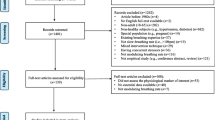Abstract
Objective
Both psychogenicity and organicity have been asserted in postural tachycardia syndrome (PoTS). We studied the genesis of palpitations to dissect the biologic nature of PoTS.
Methods
Eleven PoTS patients and 10 control subjects were asked to discriminate types of palpitations when supine and in response to two sympathetic stimuli [Valsalva maneuver (VM) and 10-min head-up tilt (HUT)] and one vagolytic stimulus (atropine administration). Participants rated the 10 items of the somatosensory amplification scale to assess symptom exaggeration. Their time-dependent heartbeat counts were compared against EKG data to study ability to perceive heartbeat.
Results
Maximal heart rate increase (mean ± SE) over baseline (bpm) did not differ statistically between patients and controls (VM, 39.3 ± 4.7 versus 28.9 ± 3.9, respectively; p = 0.11; HUT, 42.4 ± 4.2 versus 34.7 ± 2.6, respectively; p = 0.14; and atropine, 47.8 ± 2.5 versus 52.0 ± 2.1, respectively; p = 0.22). Palpitations were more frequent in patients at baseline (55 versus 0 %, p = 0.006) and with VM (82 versus 10 %, p = 0.001) and HUT (64 versus 0 %, p = 0.002), but not with atropine (64 versus 60 %, respectively; p = 0.86). Patients discriminated more types of palpitations than did controls (seven versus three types). No difference was observed in somatosensory amplification or heartbeat perception.
Interpretation
Palpitations were independent of tachycardia and were predominantly sympathetically mediated. The lack of somatosensory amplification militated against psychogenicity. PoTS patients were not superior in detecting peripheral cardiac sensation. However, patients were superior in discriminating palpitations qualitatively in response to individual stimuli, suggesting central visceral sensitization. Explanation of the nature of symptoms and pharmacologic management may be of therapeutic benefit.
Similar content being viewed by others
References
Barsky AJ, Wyshak G, Klerman GL (1990) The somatosensory amplification scale and its relationship to hypochondriasis. J Psychiatr Res 24:323–334
Benarroch EE (2012) Postural tachycardia syndrome: a heterogeneous and multifactorial disorder. Mayo Clin Proc 87:1214–1225
Benrud-Larson LM, Sandroni P, Haythornthwaite JA et al (2003) Correlates of functional disability in patients with postural tachycardia syndrome: preliminary cross-sectional findings. Health Psychol 22:643–648
Brugada P, Gursoy S, Brugada J et al (1993) Investigation of palpitations. Lancet 341:1254–1258
Cervero F (1995) Visceral pain: mechanisms of peripheral and central sensitization. Ann Med 27:235–239
Fraser F, Wilson RM (1918) The sympathetic nervous system and the irritable heart of soldiers. Br Med J 2:27–29
Gantt WH (1960) Cardiovascular component of the conditional reflex to pain, food and other stimuli. Physiol Rev Suppl 4:266–291
Henderson LA, Macey PM, Macey KE et al (2002) Brain responses associated with the Valsalva maneuver revealed by functional magnetic resonance imaging. J Neurophysiol 88:3477–3486
Khurana RK (1995) Orthostatic intolerance and orthostatic tachycardia: a heterogeneous disorder. Clin Auton Res 5:12–18
Khurana RK (2006) Experimental induction of panic-like symptoms in patients with postural tachycardia syndrome. Clin Auton Res 16:371–377
Khurana RK, Craig FW, Lynch JJ (2002) Panic symptoms in patients with orthostatic intolerance and orthostatic tachycardia. Neurology 58:A346
Khurana RK, Jones AD (1999) Assessment of minimum vagolytic dose of atropine. Neurology 52:A343
Khurana RK, Mittal D, Dubin NH (2011) Valsalva maneuver: shortest optimal expiratory strain duration. J Commun Hosp Int Med Perspect 1:7015. doi:10.3402/jchimp.v1i2.7015
Khurana RK, Nicholas EM (1996) Head-up tilt table test: how far and how long? Clin Auton Res 6:335–341
Kostrzewa RM (2007) The blood-brain barrier for catecholamines: revisited. Neurotox Res 11:261–271
Masuki S, Eisenach JH, Johnson CP et al (2007) Excessive heart rate response to orthostatic stress in postural tachycardia syndrome is not caused by anxiety. J Appl Physiol 102:896–903
Mathias CJ, Low DA, Iodice V et al (2012) Postural tachycardia syndrome: current experience and concepts. Nat Rev Neurol 8:22–34
Oppenheimer SM, Gelb A, Girvin JP et al (1992) Cardiovascular effects of human insular cortex stimulation. Neurology 42:1727–1732
Price DD, Craggs JG, Zhou Q et al (2009) Widespread hyperalgesia in irritable bowel syndrome is dynamically maintained by tonic visceral impulse input and placebo/nocebo factors: evidence from human psychophysics, animal models, and neuroimaging. Neuroimage 47:995–1001
Raj SR, Black BK, Biaggioni I et al (2009) Propranolol decreases tachycardia and improves symptoms in the postural tachycardia syndrome: less is more. Circulation 120:725–734
Raj V, Haman KL, Raj SR et al (2009) Psychiatric profile and attention deficits in postural tachycardia syndrome. J Neurol Neurosurg Psychiatry 80:339–344
Sandroni P, Opfer-Gehrking TL, McPhee BR et al (1999) Postural tachycardia syndrome: clinical features and follow-up study. Mayo Clin Proc 74:1106–1110
Schandry R (1981) Heart beat perception and emotional experience. Psychophysiology 18:483–488
Spratt KA, Michelson EL (2005) Evaluation of the patient with palpitations and non-life-threatening cardiac arrhythmias. In: Cardiology for the primary care physican, 4th edn. Current Medicine LLC, Philadelphia, pp 77–84
Wood P (1941) Da Costa’s syndrome: aetiology lecture III. Br Med J 1:845–851
Acknowledgments
I thank Norman Dubin, PhD., for statistical analysis and Lyn Camire, MA, ELS, for editorial assistance.
Conflict of interest
The author reports no conflict of interest.
Author information
Authors and Affiliations
Corresponding author
Rights and permissions
About this article
Cite this article
Khurana, R.K. Visceral sensitization in postural tachycardia syndrome. Clin Auton Res 24, 71–76 (2014). https://doi.org/10.1007/s10286-014-0227-0
Received:
Accepted:
Published:
Issue Date:
DOI: https://doi.org/10.1007/s10286-014-0227-0




